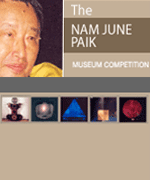백남준 미술관 국제 아이디어 설계경기
THE NAM JUNE PAIK MUSEUM INTERNATIONAL IDEAS COMPETITION
 |
유형 | UIA인증 국제설계경기 | 형식 | 아이디어 설계경기 |
|---|---|---|---|---|
| 주최 | 경기문화재단 | 주관 | 경기문화재단 | |
| 대상 | 공개설계경기 | 자격 | 건축사 | |
| 시상규모 | First prize winner(1) | Second prize winner(1) | Third prize winner(1) | Three Honorable mentions(3) | |||
| 전체일정 | 2003-03-24 ~ 2003-08-29 | URL | http://njpmuseum.cric.or.kr | |
| 접수일정 | 2003-03-24 ~ 2003-05-17 | 마감 | 작품전시중 | |
In March 2003, the Kyonggi Cultural Foundation launched a single stage, open,international ideas competition for the design of a museum devoted to the work of the
artist Nam June Paik. In conformity with the UNESCO-UIA regulations, this competition was approved by the International Union of Architects (UIA).
The aim of the competition was to select an architectural design of excellence so that the selected architect(s) and Nam June Paik might jointly create a work of architecture in tune with the pioneering, artistic spirit of the artist.
With an overall surface of some 5000 m2, the future museum will house the artist's collections and will offer an environment for his future creative activities. The building will also have the vocation of promoting Kyonggi province as an international centre for the arts and culture.
The international jury was presided jointly by Odile Decq, architect (France)representing the UIA and Jong Soung Kimm, architect (Korea). The members were: Jin-Kyoon Kim, architect (Republic of Korea), President of the Federation of Institutes of Korean Architects (FIKA), Ki Soo Oh, President of the Korean Institute of Architects (KIA), Axel Schultes, architect (Germany). Arato Isozaki, architect (Japan), was unable to attend the first day's deliberations and in accordance with the UNESCO-UIA regulations, was replaced, as titular member, by deputy member Roberto Simon, architect (Brazil). Ricardo Scofidio, architect (USA), unable to participate in the jury for health reasons, was replaced, in agreement with the UIA, by John Hanhardt (USA), expert on the work of Nam June Paik.
For three days, the jury rigorously and enthusiastically reviewed the submitted entries and, through sometimes heated discussions and debates, finally selected the winners. The following is a brief summary of the jury process: On the first day of jury, the jurors visited the building site and John Hanhardt, the senior curator of Guggenheim museum, introduced Nam June Paik’s life and art to the jurors. The first jury was to eliminate the less qualified entries. The jurors put stickers to the less qualified entries. As a result, 362 entries were eliminated from further jury and 77 remaining entries proceeded to the next jury. In the second stage of the jury on the next day, the jurors in a group reviewed each of the 77 entries, and they selected 18 entries for further consideration. Before the third stage, the jurors reviewed the design description of each of the 18 entries. In the third stage, the jurors anonymously cast 6 votes each for the final candidates. They decided that 8 entries, that received 3 or more votes, were to be reviewed for the final winners. In the final stage on the third day of jury, the professional advisor reported to jurors about the violations the 8 remaining entries against the competition regulations. The jurors reviewed them carefully and unanimously decided that there was not any violation serious enough to force an elimination of the entry. They thought that this is an idea competition anyway and it is to pick the “best” idea, not the most “compliant” one. They decided unanimously not to drop any of the 8 entries. Then the jurors spoke of each of the 8 entries in terms of their positive and negative aspects. There were heated debates on such issues as preservation of the nature and topography, innovative ideas, flexibility, diversity, and attainability/realizability. Finally they voted for the first prize and two entries were tied. After a long discussion and debate once again, the jurors unanimously selected the first prize winner. They also unanimously selected the second and third prize winners. The three honorable mention winners were selected by jurors’ vote.
· First Prize
Kirsten Schemel, Kirsten Schemel Architekten (Germany)
· Second Prize
Kyu Sung Woo, Kyu Sung Woo Architect Inc (USA)
· Third Prize
Noriaki Okabe, Noriaki Okabe Architecture Network (Japan)
· Mentions
Karlheinz Sendelbach, Schneider + Sendelbach Architekten BDA (Germany)
Diego Suarez, OAV arqs (United-Kingdom)
Hannelore Deubzer, Deubzer Konig Architekten (Germany)
The followings are the jury’s comments on the winning projects:
First Prize: Kirsten Schemel
This project offers a brilliant conceptual solution to presenting the full range of Nam June Paik’s
art in multi-dimensional museum spaces. This innovative concept of a topological floor and flat
covering surface filling the geography of the valley is sophisticated. The open structure offers in
its sensitivity to Nam June Paik’s art an evolutionary conceptual design. Its treatment of the site
and flexibility of design invite a process that will create an outstanding and innovative museum
for the art of Nam June Paik.
Second Prize: Kyu Sung Woo
This project explores the terrain of the site through two interconnected volumes. Its intimate
spaces follow a practical and functional design in accommodating Nam June Paik’s art and
vision.
Third Prize: Noriaki Okabe
This was the most successful of the “bridge” type designs submitted to the competition. Its
modernist form follows a thoughtful arrangement of exhibition spaces and treatment of the
geography of the site.
Honorable Mention: Karlheinz Sendelbach
This concept responded to the location. Its intimate spaces were best suited to particular aspects
of Paik’s art.
Honorable Mention: Diego Suarez
This project employs technological concepts to design the architecture of the internal spaces. Its
dynamic treatment invites exploration of the exhibition potential of the various spaces.
Honorable Mention: Hannelore Deubzer
The formal design inserts itself instrumentally into the topography. Its plan provides classically
oriented exhibition spaces and perspectives for presenting the artwork.